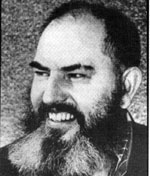![]()
|
|
|
|
|
|||
When the explorers returned to the
United States in the spring of 1930, Siple began a series of
extraordinary accomplishments. Returning to Allegheny
College, he completed three years of study in two, thereby
receiving his Bachelor of Science degree in biology in 1932.
Dr. Darling, his mentor, was instrumental in this rapid
movement and Siple forever after acknowledged his regard for
and gratitude to his dear friend. Siple participated in a
lecture tour during the years 1930 and 1931, most often
speaking to Boy Scout councils. On several of these
occasions, he and Admiral Byrd lectured together. All of the above not being enough,
Siple decided to indulge himself in a knapsack field trip of
foreign lands. In 1932, after the publication of his second
book (which, incidentally, Miss Johannesmeyer helped Paul
put together), he departed for a view of Europe (including
the Soviet Union), Asia Minor and northern Africa. While
bumping across Egypt early in 1933, word was received from
Admiral Byrd to hurry back to Boston, Massachusetts. The
Second Byrd
Antarctic Expedition was about
to begin. During this time in the Near East, Siple was
influenced by an American geographer he met, leading him to
choose geography as his future field of specialization. Not
geography, per se, but rather the effects of geographical
conditions on humans and their possessions. Several months passed after Siple's
return to civilization tying up loose ends which included
the placing of his lichens and moss specimens where they
would be identified by specialists and catalogued. In 1936
Siple wrote, and had published, his manuscript titled
Scout to Explorer which was dedicated to Admiral
Richard E. Byrd, describing the events of his second
expedition as he had experienced them. But now it was time
for Siple to decide on a wage-earning career. This decision culminated in
registration at Clark University, which was located in
Worcester, Massachusetts, and earning his Ph.D. in geography
in 1939. His dissertation Adaptations of the Explorer to
the Climate of Antarctica indicated his intentions of
approaching geography through the door which opened to
Climatology. Paul and Ruth Johannesmeyer, the young lady he
met in the registrar's office at Allegheny College in 1930,
tied the proverbial "knot" on December 29, 1936. Ruth
remembers beginning their honeymoon driving to a seminar in
Syracuse, New York. Ruth had typed up Paul's thesis, but
then had to bid her husband "au revoir" once again. In 1939,
the United States found itself viewing the Antarctic
continent with more than scientific eyes. Without hesitation, Siple joined
forces with Uncle Sam, first as a civilian employee and
then, after the attack on Pearl Harbor, he was commissioned
as an army Captain. At the end of hostilities, he was
honorably discharged as a Lieutenant Colonel. Back in
civilian clothes once more, he entered the Army Chief of
Staff's Office of Research and Development as a scientist.
This new job took him to a part of the world that had swung
National Defense attention to the blank map areas of the
Arctic Basin. It is important to note here that experiments
made by Siple and Charles F. Passel during the austral
winter of the United States Antarctic Service Expedition
firmed up Siple's earlier research on wind-chill factors. An
index of wind-chill numbers was derived and the findings
were published in the journal of the American Philosophical
Society. Another, even more wonderful, event had occurred on
Siple's return. For the very first time, he met his first
daughter, Ann Byrd Siple, born on June 9, 1940 during his
absence with the USASE at Little America III. It was on October 16, 1946 that Siple
and Robert N. Davis, an analyst for the Strategic Air
Command, accompanied a United States Air Force B-29 air crew
on the first extended-long-range flight over the
geographic North Pole. Major Maynard E. White, USAF,
commander of the highly classified 46th/72nd Reconnaissance
Squadron and "Project Nanook" also was aboard as an
observer. This mission was also the first ever made
during the boreal night and, additionally, the first
flight allowing the aviators to know the exact moment that
the Pole was reached. During these years of the late 1940's,
studies were made by the reconnaissance squadron
encompassing survival rations and equipment, navigational
aids, weather reporting and national defense possibilities.
Air searches for previously unknown land masses resulted in
the locating of what appeared to be an island on October
14,1946 but proven later to be a floating ice island.
Landings were made on Target-X, as it was designated,
and determination was made that the island originated in a
glacial fjord of Greenland. The finding of Target-X
(redesignated "T-1"), followed by discovery of "T-2" and
"T-3" (later known as Fletcher's Ice Island), opened the
door to future use of these islands as mobile scientific
stations. Siple, always willing to tackle another geographic
phenomenon, sought to establish the rate of movement of the
north magnetic pole and what would be the result should this
pole and the geographic pole converge. To this end, he
worked with both the Air Force Reconnaissance Squadron
operating out of Ladd Field in Fairbanks, Alaska (whose
records were only de-classified in 1988) as well as
Remington Rand Corp. laboratory experiments. Once again,
however, Admiral Byrd enters the picture. Byrd had gained the ear of the
Secretary of the Navy as well as that of the Chief of Naval
Operations, Fleet Admiral Chester W. Nimitz, resulting in an
enormous naval operation impressively titled The United
States Navy Antarctic Developments Program, 1946-47 but
better known as Operation
Highjump. Siple departed
Norfolk, Virginia, on December 2, 1946 aboard the
U.S.S.
Mount Olympus (AGC-8)
as Scientific and Polar Advisor as well as Senior
Representative of the U.S. War Department.. A tent city was
established at Little America IV in the Bay of Whales just
adjacent to the air strip built to handle the reconnaissance
planes due to arrive from the aircraft carrier
U.S.S.
Philippine Sea (CV-47)
laying just outside the pack ice. Admiral Byrd was coming in
on the first plane. Even these responsibilities filling
his mind, he found his thoughts ever more on his family life
when away from home. Ruth had presented him with a second
daughter, Jane Paulette Siple, on October 11, 1942 and a
third daughter, Mary Cathrin Siple, on October 26, 1946 just
two months before embarking on Highjump. At the other
end of the emotional scale came news of his father's death
just as he was approaching the Antarctic coast. Later, word
arrived of his mother breaking her hip. Had someone,
perhaps, shot an albatross on the way south? By April 1947 most of the ships and
men involved with the expedition were back in the United
States. Much had been accomplished in the last four months,
both at Little America IV and along the coastline of the
continent. Politics and post-war economy interfered with a
proposed Highjump II set previously for 1949-50.
However, it was allowed that a follow-up expedition take
place in the austral summer of 1947-48 known as The U.S.
Navy Second Antarctic Developments Project,, or
Operation
Windmill. This involved
two Navy icebreakers, U.S.S.
Burton Island and
U.S.S. Edisto, to provide geodetic ground control to
match parts of certain photographs taken from
Highjump aircraft. Siple was not a member of this
strictly Navy project. For the remainder of his life Siple
continued as a cog in the wheels of the Research and
Development Office of the U.S. Army. More precisely, Special
Scientific Advisor, Army Research Office, Office of the
Chief of Research and Development, Department of the Army.
An appropriate handle for a scientist who held eight
patents for the development of clothing, protective devices
and building design. His research extended not only to the
polar regions but encompassed desert, mountain and humid
tropical conditions. Seven continents and most major island
masses have held the weight of his body and bear his
footprints. During the Korean War (1950-53) he traveled the
length of the battle lines, on which American military
personnel were risking their lives, checking on the
equipment. A seed had been planted in Siple's
mind in the early 1950's when whispers of renewed national
interest in Antarctica began to be heard. He wanted to know
if these concerns were good or bad and, in order to find out
he joined with those who were involved. Then, suddenly, our
national interests bumped into the international
geophysicists' desire for an International Geophysical Year.
Siple's participation eventually evolved into his acceptance
of Director of Scientific Projects for Operation
Deepfreeze I, 1955-56. The
National Program, our Defense Department and the IGY became
bed-fellows and Siple was in the thick of it. In the course
of planning the part that the United States would play,
agreement was reached to provide scientific stations in
Marie Byrd Land (Byrd Station), on the Filchner Ice Shelf
(Ellsworth Station) and on the Clark Peninsula (Wilkes
Station). Pushing their luck even further, it was suggested
that a station be constructed and manned at Latitude 90
degrees South. Silence prevailed as the air was expelled
from the lungs of the conference delegates. This decision
was put on hold. Siple was excused from his duties with
the Army by the Department of Defense and ordered to take
over the scientific projects for Task Force 43.
South Pole
Station was given the
go-ahead, but a support base had to be built at McMurdo
Sound. An additional station, Little America V, was also
required near the old site of the former Little America(s)
to provide support for the building of Byrd Station. On
December 18, 1955, Siple arrived at McMurdo Station which
coincided with his 47th birthday. On January 8, 1956, he
made a flight to the South Pole with Admiral Byrd, Officer
in Charge of the U.S. Antarctic Programme 1955-57. A landing
was prohibited but he had wanted in the worst way to examine
the surface conditions on the plateau. On February 3, 1956,
both men returned to the United States. Byrd had no way of
knowing that this would be the last time he would ever see
the Antarctic continent. At this point, prior to Deepfreeze II
1956-57, Siple gave little thought of returning to the
continent himself, let alone spending another austral winter
there. He would soon be 48 years of age and fondly hoped
that he would spend his daughter's teen-age years at home
with them. Further he was deeply displeased with the
decision that the IGY stations would have split commands
whereby there would be a scientific leader and a military
leader. He fended off several requests to take over as
scientific leader at the South Pole but, once again, he
found it impossible to say "no" to his friend Admiral Byrd
and the U.S. Department of Defense. Only one
consolation was offered in that if he was not satisfied that
it would be safe to live at the Pole, he could call it
off. "Write me often," Siple said
emotionally to his family and friends as he boarded the
plane which would carry him on the first leg of his journey
to the very end of the earth. It was October 4, 1956,
another rainy day. Towards the end of the month, he found
himself aboard the first U.S. Air Force plane to fly over
the South Pole (it did not land), giving him the distinction
of having been aboard the first two USAF aircraft to fly
over the geographic poles. On November 20, 1956, the advance
construction party was flown to the plateau site to begin
erection of the station, but Siple was not permitted to
board a plane at McMurdo until November 30th. November 30, 1957, after exactly one
year to the day since his arrival at the Pole, Siple shaved
off his beard, put on clean clothes, packed his gear, said a
silent prayer of thanksgiving, took a last look at the
plateau, then entered the door of his plane. He had a
one-way ticket to McMurdo, then on to Christchurch, New
Zealand where the rain was pelting down. Eighteen men had
witnessed the sunset and sunrise on the South Polar Plateau
for the first time in history. During his time at the Pole
he had been featured on the front cover of the December 31,
1956 issue of Time magazine and his article, We
are Living at the South Pole, was published in the July,
1957 issue of the National Geographic
Magazine. Five months after his return to
civilization, Siple received the prestigious Hubbard Medal
during a ceremony at the National Geographic Society
headquarters. The affair took place on March 28, 1958, and
was described in the National Geographic issued June, 1958.
A previous article by Siple, Man's First Winter at the
South Pole, had appeared in the April, 1958 issue. The
following year his book 90 Degrees South, a
compendium of his life as well as the time spent at the
South Pole, appeared in bookstore windows. These products
from the mind of Paul Siple were completed while he thrived
in the atmosphere of a loving home and a job he relished at
the Army Research Office. From 1963-66 he served as the first
U.S. Scientific Attache to Australia and New Zealand,
bridging together scientists of all disciplines. While
performing these duties at Wellington, New Zealand in June,
1966, he suffered a partial paralytic stroke and had to
return to the United States. For more than two years, his
smile and good humor never failing, he continued to work
with the Army - - his left arm in a sling and a four-legged
crutch grasped in his right. On November 25, 1968 he
answered the summons of his Creator having sustained a fatal
heart attack while seated at his desk. He was just 59 years
of age. Russell Owen, a correspondent for the
New York Times, was assigned the coverage of the
first Byrd Antarctic Expedition of 1928-30 as a
wintering-over member. In 1934 Owen's book, South of the
Sun, was published describing his experiences at Little
America I during those years. He used a rather peculiar
style of referring to the expedition members within its
pages - - a style that this writer was unfamiliar with - -
in that given names were not used but, rather, title,
occupation, or job description. For example, Lawrence Gould,
geologist and second in command, was referred to as "the
Geologist". Captain Ashley McKinley, aerial surveyor and
third in command, was always alluded to as "the Captain,"
and so on. If one were not familiar with the names of the
residents of Little America I from other sources, Owen's
literary effort would be quite confusing and less than
informative. However, out of this muddle there were a few
easily recognized personalities such as "the Commander"
(Cdr. Byrd) and "the Boy Scout" (Paul A. Siple). The Boy
Scout was as readily known then as he is even today, i.e.
"The Eagle Scout who went with Byrd to the
Antarctic". Here is the way Owen described the
young man who was later to become one of the greatest polar
explorer / scientists of this century. "Perhaps no Boy Scout
ever so belied his name. He was six feet tall, weighed in
mid-winter more than two hundred pounds and had had his
twenty-first birthday on the ice. He worked hard, kept his
mouth shut, listened without comment to the ribaldry that
went on about him, and never took part in it. He had the
poise of a much older and experienced man." A succinct
resume that indicates a familiarity with, and admiration
for, this exemplary representative of the Boy Scouts of
America. It is a well known dictum that in the Antarctic one
can not hide one's real nature. It is safe to say that Siple
maintained the admirable qualities mentioned by Owen for the
rest of his life judging by the four books he has authored,
the comments of other writers who came to know him and the
average person meeting him in more relaxed moments. This
huge man with a gentle soul once wrote that he could be
caught wasting time as much as the next guy, lolling in the
sand at the beach, attending social functions, taking in a
good movie, reading whatever literature first came to his
hand, keeping physically fit and enjoying athletics. At any
point in time, one could accurately describe Paul Siple as a
man's man. He was curious, yes, but not singly so. James E.
West, Chief Scout Executive in 1928, wrote that "the choice
of Paul Siple, (to join the Byrd Expedition) I think, can be
fully understood when his peers, the Scouts competing for
the appointment, agreed that Scout Siple would be one of the
two persons each would want as a companion if it were
possible to send three Scouts to the Antarctic." In other
words, he was chosen as the candidate for participation in
Byrd's expedition by his actual competition. Those judging
the scouts added that, ". . .he is the type of boy that is
always smiling; he is energetic; he has splendid leadership
qualifications." Not only in 1928, but as late as 1957
at South Pole Station he was described, at 48 years of age,
to be the first to dig-in (literally, in the snow mine), the
last to seek warmth, and physically out-performed men many
years his junior in the thin air of the plateau. Firm in his
decisions as to what he considered best for his fellow
scientists and the navy men at the station, he initiated
seminars and lectures in lieu of "daily" Hollywood movies.
In spite of extreme cold temperatures averaging between -60
and -80 degrees F. and dipping as low as -102 degrees F. on
September 17, 1957, he and Navy Lt. (j.g.) John Tuck
(military leader at the station) took star shots to
determine, as closely as possible, the location of the
geographic South Pole. Years later, after having spent four
winters and ten summers on the continent of Antarctica,
Siple's behavior was that of the same boy described
by James West in 1928. Paul Siple, explorer, scientist,
inventor, environmentalist, was above all else a Boy Scout
and remained so during his life. He has told us that his
Scout training formed the wedge which allowed him to remain
at Little America I in 1929. He believed, and convinced
Larry Gould, that he could provide penguin and seal skins
for the American Museum of Natural History which the
geologist had promised but would not be able to furnish
himself due to more pressing obligations to the expedition.
In this manner he met Byrd's criteria that, " . . . everyone
who stays on the ice will have to have a reason." Siple's
journey of a thousand miles began with that first step in
January 1929. For generations to come the name Siple will be
evident to those who study and / or visit the Antarctic
Continent. On Siple Island (located at 73° 39'S,
125° 00'W) can be found Mount Siple (73° 15'S,
126° 06'W). If one may be inclined to traverse to Siple
Coast it will be found at 82° 00'S, 155° 00'W.
Then in 1969 the United States constructed a scientific
installation at 76°S, 84' W in Ellsworth Land and named
it Siple Station. Siple and Byrd were once again "together"
(Byrd Station had been opened in 1957 in Marie Byrd
Land). Friendships do not really end with the
passing of bosom friends. Sometimes those left behind see to
it that names are linked together as long as metal and stone
can withstand rust and disintegration. On June 21, 1993 a
ceremony took place in Wellington, New Zealand at the
Admiral Richard E. Byrd Memorial whereby the monument's
restoration and re-dedication were solemnized. At this time
a plaque was added at the foot of this artistically clad
shrine honoring the late Paul A. Siple's accomplishments as
well as his close partnership with Byrd. These two friends,
the Admiral and the Boy Scout, are again linked together as
they were way back there on the ice in 1929. This article was reproduced by
permission from the author, Joseph Lynch, Jr., a fellow
polar philatelist specializing in Byrd I, II, III and
Operation Highjump; from a series in the "Ice Cap News", the
official journal of the American Society of Polar
Philatelists. (Vol. 40, No. 3 & 4; Vol 41, No. 1 &
2)
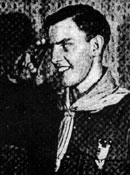 Paul
Allen Siple saw the first light of day on December 18, 1908,
in Montpelier, Ohio. The proud parents were Clyde L. Siple
and his wife Fannie Hope (Allman) Siple. When Paul was about
ten years of age the family moved to Erie, Pennsylvania,
where two years later he joined the Boy Scouts of America.
Merit badge work held the greatest interest for him and by
the time he was eighteen, sixty of these badges had been
earned. Thinking of his efforts as an adventure in
exploring, he applied himself to the study of insects,
radio, woodwork, art, athletics, first aid, bee-keeping, and
many other areas of science as well as pragmatic subjects.
It was during this period of time that Siple found the
assurance of God for himself and wrote that, "Only a Supreme
Mind could have designed the harmonious and beautiful world
of which I was becoming aware for the first time." His first
knowledge of Captain Robert
F. Scott's ill-fated journey
came during a Sea Scout session aboard the retired brig
Niagra when his Sea Scout leader read the story to
his troop. It was at that moment his first desire to visit
distant, frozen lands was ignited.
Paul
Allen Siple saw the first light of day on December 18, 1908,
in Montpelier, Ohio. The proud parents were Clyde L. Siple
and his wife Fannie Hope (Allman) Siple. When Paul was about
ten years of age the family moved to Erie, Pennsylvania,
where two years later he joined the Boy Scouts of America.
Merit badge work held the greatest interest for him and by
the time he was eighteen, sixty of these badges had been
earned. Thinking of his efforts as an adventure in
exploring, he applied himself to the study of insects,
radio, woodwork, art, athletics, first aid, bee-keeping, and
many other areas of science as well as pragmatic subjects.
It was during this period of time that Siple found the
assurance of God for himself and wrote that, "Only a Supreme
Mind could have designed the harmonious and beautiful world
of which I was becoming aware for the first time." His first
knowledge of Captain Robert
F. Scott's ill-fated journey
came during a Sea Scout session aboard the retired brig
Niagra when his Sea Scout leader read the story to
his troop. It was at that moment his first desire to visit
distant, frozen lands was ignited.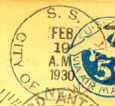 Upon
graduation from high school, he took a job working as an
assistant draftsman for a year so that money could be saved
for entering college. The following year he entered
Allegheny College in Meadville, Pennsylvania and through the
encouragement of Dr. Chester A. Darling, head of the Biology
Department and a local Scoutmaster, chose biology for his
major course in college. Spring examinations terminated, the
summer was spent working as a nature instructor in a boy's
camp with honest intentions of returning to school for his
sophomore year in September. However, when class opened in
the fall of 1928, Paul Siple was earning his sea-legs on
board Commander Richard
E. Byrd's Antarctic Expedition
flagship City of New York as the official
representative of the Boy Scouts of America. Siple spent the
next eighteen months either at sea or on the Antarctic
continent living like "civilized rats" in close quarters
with 41 other men. His association and friendship with
Richard E. Byrd had been incubated, given birth, and tightly
interlocked until the Admiral's death on March 11,
1957.
Upon
graduation from high school, he took a job working as an
assistant draftsman for a year so that money could be saved
for entering college. The following year he entered
Allegheny College in Meadville, Pennsylvania and through the
encouragement of Dr. Chester A. Darling, head of the Biology
Department and a local Scoutmaster, chose biology for his
major course in college. Spring examinations terminated, the
summer was spent working as a nature instructor in a boy's
camp with honest intentions of returning to school for his
sophomore year in September. However, when class opened in
the fall of 1928, Paul Siple was earning his sea-legs on
board Commander Richard
E. Byrd's Antarctic Expedition
flagship City of New York as the official
representative of the Boy Scouts of America. Siple spent the
next eighteen months either at sea or on the Antarctic
continent living like "civilized rats" in close quarters
with 41 other men. His association and friendship with
Richard E. Byrd had been incubated, given birth, and tightly
interlocked until the Admiral's death on March 11,
1957.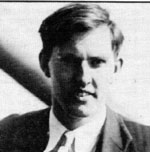 Siple
contained enough energy to have two books published by G.P.
Putnam's Sons. A Boy Scout With Byrd saw print in the
winter of 1931, followed by Exploring At Home in
September of 1932. The former book contains an appendix by
James E. West, Chieft Scout Executive, detailing the entire
process that provided the opportunity for a Boy Scout to
accompany the First Byrd Antarctic Expedition. I have to
believe, however, that the most important piece of good
fortune to enter Paul Siple's life occurred in Meadville,
Pennsylvania in 1930. On this rainy day occasion Siple met a
young lady in the registrar's office at Allegheny College by
the name of Ruth Ida Johannesmeyer and offered to drive her
home.
Siple
contained enough energy to have two books published by G.P.
Putnam's Sons. A Boy Scout With Byrd saw print in the
winter of 1931, followed by Exploring At Home in
September of 1932. The former book contains an appendix by
James E. West, Chieft Scout Executive, detailing the entire
process that provided the opportunity for a Boy Scout to
accompany the First Byrd Antarctic Expedition. I have to
believe, however, that the most important piece of good
fortune to enter Paul Siple's life occurred in Meadville,
Pennsylvania in 1930. On this rainy day occasion Siple met a
young lady in the registrar's office at Allegheny College by
the name of Ruth Ida Johannesmeyer and offered to drive her
home.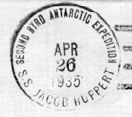 Preparations
for the expedition were proceeding in a rather hectic
manner. In order to cut expenses Byrd, as he did for his
first Antarctic expedition, asked the men who were to go
along to agree to serve for $1 a year. This done, financing
and logistics were, relatively speaking, "nailed down" and
Siple boarded a re-christened freighter, Jacob
Ruppert. With the chief Biologist aboard, the ship
departed Bayonne, New Jersey on October 13, 1933, not to see
the United States again until the expedition disbanded in
1935.
Preparations
for the expedition were proceeding in a rather hectic
manner. In order to cut expenses Byrd, as he did for his
first Antarctic expedition, asked the men who were to go
along to agree to serve for $1 a year. This done, financing
and logistics were, relatively speaking, "nailed down" and
Siple boarded a re-christened freighter, Jacob
Ruppert. With the chief Biologist aboard, the ship
departed Bayonne, New Jersey on October 13, 1933, not to see
the United States again until the expedition disbanded in
1935.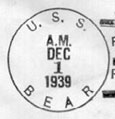 Politics
now became a factor prompting the U.S. government not only
to intrude into Byrd's plans for a third expedition but to
literally take over. Rather than a "third Byrd" it was
officially titled the United
States Antarctic Service Expedition
of 1939-41 (the latter date after-the-fact due to the
beginning of another World War). Siple, at Byrd's urging,
was assigned the leadership of the base set up at the Bay of
Whales (a.k.a. West Base / Little America III) but
additionally handled the logistics for the entire
expedition. He boarded the USMS North Star on
November 21, 1939, as part of the package that intended to
colonize Antarctica, and departed Philadelphia,
Pennsylvania. Returning home in the spring of 1941 when the
U.S.S. Bear arrived at Boston, Massachusetts he was
met by a gentleman from the United States Quartermaster
Corps who explained to him that the government required his
help as a cold weather expert. He also expressed the view
that if we were to become involved in the war, fighting
might take place in all climates.
Politics
now became a factor prompting the U.S. government not only
to intrude into Byrd's plans for a third expedition but to
literally take over. Rather than a "third Byrd" it was
officially titled the United
States Antarctic Service Expedition
of 1939-41 (the latter date after-the-fact due to the
beginning of another World War). Siple, at Byrd's urging,
was assigned the leadership of the base set up at the Bay of
Whales (a.k.a. West Base / Little America III) but
additionally handled the logistics for the entire
expedition. He boarded the USMS North Star on
November 21, 1939, as part of the package that intended to
colonize Antarctica, and departed Philadelphia,
Pennsylvania. Returning home in the spring of 1941 when the
U.S.S. Bear arrived at Boston, Massachusetts he was
met by a gentleman from the United States Quartermaster
Corps who explained to him that the government required his
help as a cold weather expert. He also expressed the view
that if we were to become involved in the war, fighting
might take place in all climates. Navy
yeoman Robert Chaudoin, temporary postal clerk at the
station, broke out his equipment and struck a December 15,
1956 cancel on nearly a quarter-million pieces of mail which
had arrived by plane. Pole Station, Antarctica, was
now for real. On October 27, 1957, after eight months of
isolation, a C-124 appeared overhead and air-dropped a load
of supplies and personal mail. Thoughts of loved ones and
friends intensified.
Navy
yeoman Robert Chaudoin, temporary postal clerk at the
station, broke out his equipment and struck a December 15,
1956 cancel on nearly a quarter-million pieces of mail which
had arrived by plane. Pole Station, Antarctica, was
now for real. On October 27, 1957, after eight months of
isolation, a C-124 appeared overhead and air-dropped a load
of supplies and personal mail. Thoughts of loved ones and
friends intensified.